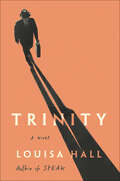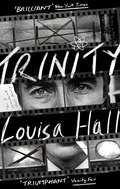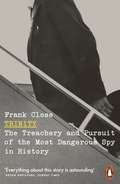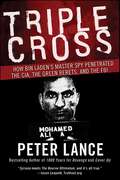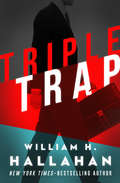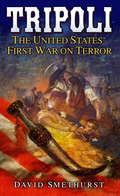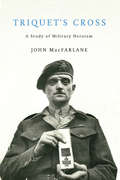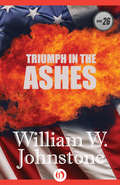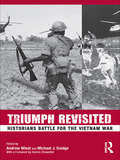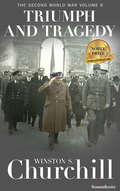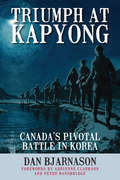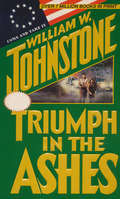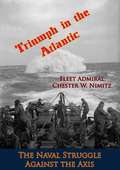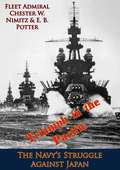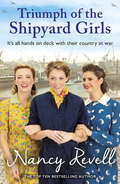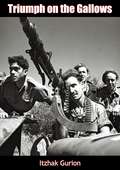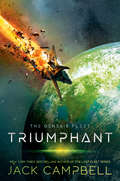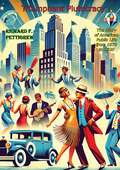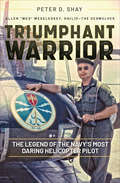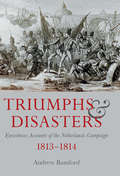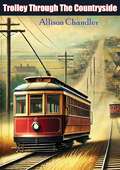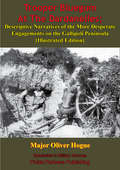- Table View
- List View
Trinity: A Novel
by Louisa HallFrom the acclaimed author of Speak comes a kaleidoscopic novel about Robert Oppenheimer—father of the atomic bomb—as told by seven fictional charactersJ. Robert Oppenheimer was a brilliant scientist, a champion of liberal causes, and a complex and often contradictory character. He loyally protected his Communist friends, only to later betray them under questioning. He repeatedly lied about love affairs. And he defended the use of the atomic bomb he helped create, before ultimately lobbying against nuclear proliferation.Through narratives that cross time and space, a set of characters bears witness to the life of Oppenheimer, from a secret service agent who tailed him in San Francisco, to the young lover of a colleague in Los Alamos, to a woman fleeing McCarthyism who knew him on St. John. As these men and women fall into the orbit of a brilliant but mercurial mind at work, all consider his complicated legacy while also uncovering deep and often unsettling truths about their own lives.In this stunning, elliptical novel, Louisa Hall has crafted a breathtaking and explosive story about the ability of the human mind to believe what it wants, about public and private tragedy, and about power and guilt. Blending science with literature and fiction with biography, Trinity asks searing questions about what it means to truly know someone, and about the secrets we keep from the world and from ourselves.
Trinity: Shortlisted for the Dylan Thomas Prize
by Louisa Hall'Brilliant . . . Hall has shaped a richly imagined, tremendously moving fictional work. Its genius is not to explain but to embody the science and politics that shaped Oppenheimer's life . . .The resulting quantum portrait feels both true and dazzlingly unfamiliar' New York Times J. Robert Oppenheimer - the father of the atomic bomb - was a brilliant scientist, a champion of liberal causes, and a complex and often contradictory character. In Louisa Hall's kaleidoscopic novel, seven fictional characters bear witness to his life. From a secret service agent who tailed him in San Francisco, to the young lover of a colleague in Los Alamos, to a woman fleeing McCarthyism who knew him on St. John, as these men and women fall into the orbit of a brilliant but mercurial mind at work, all consider his complicated legacy while also uncovering deep and often unsettling truths about their own lives.In Trinity, Louisa Hall has crafted an explosive story about what it means to truly know someone, and about the secrets we keep from the world and from ourselves.
Trinity: The Treachery and Pursuit of the Most Dangerous Spy in History
by Frank Close'Everything about this story is astounding' Bryan Appleyard, Sunday Times"Trinity" was the codename for the test explosion of the atomic bomb in New Mexico on 16 July 1945. Trinity is now also the extraordinary story of the bomb's metaphorical father, Rudolf Peierls; his intellectual son, the atomic spy, Klaus Fuchs, and the ghosts of the security services in Britain, the USA and USSR.Against the background of pre-war Nazi Germany, the Second World War and the following Cold War, the book traces how Peierls brought Fuchs into his family and his laboratory, only to be betrayed. It describes in unprecedented detail how Fuchs became a spy, his motivations and the information he passed to his Soviet contacts, both in the UK and after he went with Peierls to join the Manhattan Project at Los Alamos in 1944. Frank Close is himself a distinguished nuclear physicist: uniquely, the book explains the science as well as the spying.Fuchs returned to Britain in August 1946 still undetected and became central to the UK's independent effort to develop nuclear weapons. Close describes the febrile atmosphere at Harwell, the nuclear physics laboratory near Oxford, where many of the key players were quartered, and the charged relationships which developed there. He uncovers fresh evidence about the role of the crucial VENONA signals decryptions, and shows how, despite mistakes made by both MI5 and the FBI, the net gradually closed around Fuchs, building an intolerable pressure which finally cracked him.The Soviet Union exploded its first nuclear device in August 1949, far earlier than the US or UK expected. In 1951, the US Congressional Committee on Atomic Espionage concluded, 'Fuchs alone has influenced the safety of more people and accomplished greater damage than any other spy not only in the history of the United States, but in the history of nations'. This book is the most comprehensive account yet published of these events, and of the tragic figure at their centre.
Triple Cross: How bin Laden's Master Spy Penetrated the CIA, the Green Berets, and the FBI
by Peter Lance"A chilling account of a killer who slipped through the hands of a daft justice system….Triple Cross chronicles one of the most vicious spies of our time."—Toronto SunIn the years prior to 2001, no single agent of al Qaeda was more successful in compromising the U.S. intelligence community than Ali Mohamed. For almost two decades the former Egyptian army commando succeeded in living a double life—marrying an American woman, becoming a naturalized citizen, and infiltrating the CIA in Europe, the Green Berets at Fort Bragg, and the FBI in California—even as he helped orchestrate the campaign of terror that culminated in the 9/11 attacks.Triple Cross is award-winning investigative reporter Peter Lance's chilling true account of the career of the master spy known to his al Qaeda brothers as "Ali the American"—an explosive narrative revealing the gaping holes in our nation's security net. Finally, coming off his previous FBI exposé, Cover Up, Lance also chronicles the collapse of the Brooklyn murder trial of former FBI agent Lin DeVecchio, a case that could well have revolutionized public understanding of the background of 9/11.
Triple Trap
by William H. HallahanA spy-vs.-spy thriller from the New York Times–bestselling author. “Hallahan weaves a very effective web. . . . The novel rockets along” (Chicago Tribune). Intelligence operative Charlie Brewer has been a lone wolf since he took the fall for the CIA in a previous case. But now the official moles need him again, and though there’s no love lost, Brewer can’t resist a challenge as big as this. The target: a Soviet superspy posing as Eric Marten, a Swiss businessman with an opulent lifestyle who lives in a castle, collects art, and buys fabulous jewelry for his girlfriends. However, Eric Marten is the greatest international smugger in history. He can snatch virtually any piece of US technology for his Soviet bosses. Thanks to Marten’s diabolical genius, whole cases of computer parts disappear right from under the eyes of veteran CIA agents; blueprints for top-secret American weapons end up at the Kremlin. Marten has to be stopped. But the CIA doesn’t know his real name, much less who he is or how to catch him. It’s up to Brewer—and Marten knows it. “[Hallahan at his brisk best] . . . The action is lean and satisfying with a formidably tenacious hero, a charismatic post-glasnost villain, some clever spy puzzles and just the right dash of Le Carré-inspired cynicism.” —Kirkus Reviews
Tripoli: The United States' First War on Terror
by David SmethurstTHE TRUE STORY OF WILLIAM EATON AND THE UNITED STATES' FIRST ATTEMPT AT REGIME CHANGE. April 27, 1805. The impasse in the four-year war between the Barbary pirate state of Tripoli and the United States is about to be broken. William Eaton has led his ragtag army of Greeks, Arabs, and U.S. Marines across five hundred grueling miles of sun-scorched desert from Alexandria, Egypt, to Tripoli's heavily defended port fortress of Derna. Outnumbered ten to one, the exhausted, thirsty men carry out Eaton's daring charge on the pirate fortress-and enter the history books and anthem of the U.S. Marines.David Smethurst vividly chronicles America's Barbary War and the pivotal role of William Eaton-firebrand, soldier, and statesman. From the former army captain's appointment as consul to the Barbary Coast in 1799 to the enemy's capture of the USS Pennsylvania and her three hundred sailors to Eaton's valiant attack and its stunning aftermath, Tripoli is a fascinating tale of polished diplomacy, raw heroism, and a man as fearless and independent as the young nation he represented.
Triquet's Cross
by John MacfarlaneOne of only thirteen members of the Canadian Armed Forces to be awarded the highest military honour during the war, Triquet was later pressured to resign from the force due to the overwhelming public and political expectations that the award entailed. The role of hero did not suit Triquet and weighed heavily on him and his family. MacFarlane shows how Triquet's story was changed by those who wished to make his hero status the cornerstone in a political debate between francophones and anglophones, particularly with regard to his representing the Commonwealth despite his French-Canadian heritage.
Triquet's Cross: A Study of Military Heroism
by John MacFarlaneOne of only thirteen members of the Canadian Armed Forces to be awarded the highest military honour during the war, Triquet was later pressured to resign from the force due to the overwhelming public and political expectations that the award entailed. The role of hero did not suit Triquet and weighed heavily on him and his family. MacFarlane shows how Triquet's story was changed by those who wished to make his hero status the cornerstone in a political debate between francophones and anglophones, particularly with regard to his representing the Commonwealth despite his French-Canadian heritage.
Triumph In the Ashes (Ashes #26)
by William W. JohnstoneAfrica-a hell on earth, ignited by the burning rage of Bruno Bottger, a power- hungry lunatic living out Hitler's nightmare vision for the future. But even Bottger isn't prepared for the aftermath of his own sick ambitions. Germ warfare strategy has turned African civilians into killing machines with no conscience and no mercy. With millions already wrecking havoc, it's up to Ben Raines and his Rebels to bravely defend a country under siege. Facing a battalion of mindless maniacs bent on total annihilation is tough enough. Now Ben and his men are outnumbered ten to one by Bottger's heavily-armed troops. But Raines has a weapon nobody counted on: his own vision for the future-and a do-or-die determination to see it come true. Whatever the odds, Ben Raines and the Rebels are ready for the ultimate battle.
Triumph Revisited: Historians Battle for the Vietnam War
by Andrew WiestMore than thirty years later, the Vietnam War still stands as one of the most controversial events in the history of the United States, and historians have so far failed to come up with a definitive narrative of the wartime experience. With competing viewpoints already in play, Mark Moyar’s recent revisionist approach in Triumph Forsaken has created heated debate over who "owns" the history of America’s war in Vietnam. Triumph Revisited: Historians Battle for the Vietnam War collects critiques of Triumph Forsaken from both sides of this debate, written by an array of Vietnam scholars, cataloguing arguments about how the war should be remembered, how history may be reconstructed, and by whom. A lively introduction and conclusion by editors Andrew Wiest and Michael Doidge provide context and balance to the essays, as well as Moyar’s responses, giving students and scholars of the Vietnam era a glimpse into how history is constructed and reconstructed.
Triumph and Tragedy: Triumph And Tragedy (Winston S. Churchill The Second World Wa #6)
by Winston S. ChurchillWinston Churchill recounts the end of WWII and its aftermath, in the conclusion of his majestic six-volume history. In Triumph and Tragedy, British prime minister Winston Churchill provides in dramatic detail the endgame of the war and the uneasy meetings between himself, Stalin, and Truman to discuss plans for rebuilding Europe in the aftermath of devastation. Beginning with the invasion of Normandy, the heroic landing of the Allied armies and the most remarkable amphibious operation in military history, Churchill watches as the uneasy coalition that had knit itself together begins to fray at Potsdam, foreshadowing the birth of the Cold War. Triumph and Tragedy is part of the epic six-volume account of World War II told from the viewpoint of a man who led in the fight against tyranny, and enriched with extensive primary sources including memos, letters, orders, speeches, and telegrams, day-by-day accounts of reactions as the drama intensifies. Throughout these volumes, we listen as strategies and counterstrategies unfold in response to Hitler&’s conquest of Europe, planned invasion of England, and assault on Russia, in a mesmerizing account of the crucial decisions made as the fate of the world hangs in the balance.
Triumph at Kapyong: Canada’s Pivotal Battle in Korea
by Dan BjarnasonApril 24th, 1951,was a lonely, moon-lit night in Korea. On a godforsaken hill, a few hundred surrounded Canadian soldiers waited for the fight of their lives to begin. Soon, Chinese communist troops in their thousands, swarmed around them, plunging straight towards the Korean capital, Seoul. These Canadians were all that blocked the way. This is the story of the first battle by Canada’s first soldiers in the Korean War: the 2nd Battalion of Princess Patricia’s Canadian Light Infantry. These volunteers were straight from Central Casting: truck drivers, construction workers, kids just out of high school, and bored farm boys. Outnumbered and outgunned, this people’s army of amateurs beat off some of the toughest troops on earth. This battle that’s become a legend takes its name from a nearby peanut-sized village: Kapyong. It’s become a mythic Canadian story, except this is mythology that is true and real.
Triumph in the Ashes (Ashes #27)
by William W. JohnstoneAfter a nuclear holocaust, an ex-soldier and his rebels fight a Nazi madman in Africa in this adventure from a USA Today–bestselling author. Africa—ignited by the burning rage of Bruno Bottger, a power-hungery lunatic living out Hitler's nightmare vision for the future. But even Bottger isn't prepared for the aftermath of his own sick ambitions. Germ warfare strategy has turned African civilians into killing machines with no conscience and no mercy. With millions already wreaking havoc, it's up to Ben Raines and his Rebels to bravely defend a country under siege. Facing a battalion of mindless maniacs bent on total annihilation is tough enough. Now Ben and his men are outnumbered ten to one by Bottger's heavily armed troops. But Ranies has a weapon nobody counted on: his own vision for the future—and a do-or-die determination to see it come true.Whatever the odds, Ben Raines and the Rebels are ready for the ultimate battle... Twenty-sixth in the long-running series!
Triumph in the Atlantic: The Naval Struggle Against the Axis
by E. B. Potter Fleet Admiral Chester W. NimitzHere is one of the most authoritative, thoroughly documented accounts of Allied naval action in the Atlantic and Mediterranean theaters of World War II.Normandy, Salerno, Operation Neptune, Morocco--this is the story of naval warfare such as the world had never before seen. TRIUMPH IN THE ATLANTIC presents the exciting narrative of Atlantic Surface Operations in all its dramatic detail, from the sinking of the British liner Athenia in 1939 to the devastating defeat of Germany in 1945.The Atlantic operation was a sea war that made the land war in Europe and Africa possible. It was a sea war fought over the range of the Atlantic and the Mediterranean against the worst hazards men could invent and the worst nature could provide. Through U-boat and surface attack, air threat and minefields, piercing cold and blazing heat, mountainous seas, blinding fog and cutting winds, ships carried out their missions of bringing the troops and supplies to the men and women who needed them.The fruit of years of painstaking preparation by historians at the U.S. Naval Academy, TRIUMPH IN THE ATLANTIC recalls not only the tactics and maneuvers of a wartime effort unmatched in history, but also the hopes and fears of the men who made it possible.
Triumph in the Pacific; The Navy’s Struggle Against Japan
by E. B. Potter Fleet Admiral Chester W. NimitzHere in a single volume is one of the most authoritative, thoroughly documented accounts of the U.S. Navy's war against Japan.This is the story of the achievements, defeats, and victories of both the American and the Japanese navies as they met and battled in the greatest naval war of all time. This dramatic narrative brings to life both the glorious and the infamous--the decisive encounters at Midway...Guadalcanal...the Philippine Sea...Leyte Gulf...Iwo Jima...Okinawa...and the other points in the Pacific where history was made from 1941 to 1945.The information for TRIUMPH IN THE PACIFIC was gathered by historians at the Naval Academy at Annapolis under the direction of E. B. Potter, the Academy's Chairman of Naval History, and Fleet Admiral Chester W. Nimitz who, as Commander in Chief Pacific Fleet and Pacific Ocean Areas, was a principal figure in the conflict. The book is marked by authenticity, conciseness, objectivity, and the accuracy of years of painstaking research and preparation.
Triumph of the Shipyard Girls (The Shipyard Girls Series #8)
by Nancy RevellTHE EIGHTH NOVEL IN THE BESTSELLING SHIPYARD GIRLS SERIES!'Emotional and gripping' Take a Break______________________________Sunderland, 1943: With the future of Britain uncertain, the shipyard girls fight to keep their lives on an even keel. Head-welder Rosie is just about managing to keep her double life hidden from little sister Charlotte's prying eyes. But Charlotte senses something is up and, with a secret this big, the truth is bound to come out. After a whirlwind wedding, Polly must bid farewell to her sweetheart as he returns to the front line. And there is something odd about yard manager Helen's newest recruit Bel. But in resolving to uncover the truth, Helen might discover more than she bargained for... Only by rallying together will the shipyard girls triumph.______________________________Praise for Nancy Revell 'Nancy Revell knows how to stir the passions and soothe the heart!' Northern Echo 'Stirring and heartfelt storytelling' Peterborough Evening Telegraph'the author is one to watch' Sun'Well-drawn, believable characters combined with a storyline to keep you turning the pages' Woman
Triumph on the Gallows
by Itzhak GurionA fascinating story of an Israeli freedom fighter who held firm to his beliefs under the cruel British rule of Palestine at the time of the rebirth of the Israeli state.“NO one but Itzhak Gurion could have written this book. It took the sensitivity of a poet to describe the martyrdom of those who died so heroically to wrest back the ancient land of Israel from the unclean hands that have held it. Here are the images of these men and the fortitude of their souls. Here also is the picture of the henchmen and the weak-kneed lackeys of the British Government and the whole sordid business of holding a people in thraldom.“In fluent language that seems almost effortless, Gurion describes the last days of his fighting comrades in the death cells of British prisons in Israel, and I, for one, shall never again hear the HATIKVAH without thinking of the men who sang it on the way to the gallows—on which they died to make Israel live.“Here is irrefutable proof that the land of Israel would still be a dependence of its former usurpers were it not for the farsightedness and the heroism of those who realized that it could be won back by force, force of character and blood. Two thousand years of cruel oppression died at the end of the rope on which dangled the bodies of Dov Gruner and his fighting friends. If anyone can read Mr. Gurion’s book without feeling proud of belonging to the people he describes let him remove himself as far as he can from them; let him never again say that he is of the same ancestry.”—KONRAD BERCOVICI
Triumphant (Genesis Fleet, The #3)
by Jack CampbellA young fleet officer and a Marine must stand together to defend their neighbors and their colony in this return to the powerful and action-packed Genesis Fleet saga from New York Times bestselling author Jack Campbell. The recently colonized world of Glenlyon has learned that they're stronger when they stand with other star systems than they are on their own. But after helping their neighbor Kosatka against an invasion, Glenlyon has become a target. The aggressive star systems plan to neutralize Glenlyon before striking again. An attack is launched against Glenlyon's orbital facility with forces too powerful for fleet officer Rob Geary to counter using their sole remaining destroyer, Saber. Mele Darcy's Marines must repel repeated assaults while their hacker tries to get into the enemy systems to give Saber a fighting chance. To survive, Glenlyon needs more firepower, and the only source for that is their neighbor Kosatka or other star systems that have so far remained neutral. But Kosatka is still battling the remnants of the invasion forces on its own world, and if it sends its only remaining warship to help will be left undefended against another invasion. While Carmen Ochoa fights for the freedom of Kosatka, Lochan Nakamura must survive assassins as he tries to convince other worlds to join a seemingly hopeless struggle. As star systems founded by people seeking freedom and autonomy, will Kosatka, Glenlyon and others be able to overcome deep suspicions of surrendering any authority to others? Will the free star systems stand together in a new Alliance, or fall alone?
Triumphant Fox: Erwin Rommel and the Rise of the Afrika Korps (Stackpole Military History Series)
by Samuel W MitchamA military historian examines the strategic cunning of Erwin Rommel&’s first campaign in North Africa during WWII. The legend of &“The Desert Fox,&” German Field Marshal Erwin Rommel, was forged in the North African desert conflicts of World War II. It was here, as commander of Germany&’s Afrika Korps, that Rommel ignored orders from German High Command and launched his infamous West Desert campaign into Cyrenaica, now eastern Libya. Driving his exhausted Panzer forces with his indomitable will, Rommel swept through North Africa, where he brought the British Eighth Army to the brink of defeat. Although ultimately curtailed by supply shortages and logistics problems, Rommel nearly claimed the entire region for Hitler. In this stirring account of Rommel&’s first campaign, Samuel W. Mitcham, Jr. takes the reader into his subject's strategy, mindset and viewpoints.
Triumphant Plutocracy, The Story of American Public Life from 1870 to 1920
by Richard F. PettigrewExplore the tumultuous landscape of American politics and society from 1870 to 1920 with Richard F. Pettigrew's revealing work, "Triumphant Plutocracy: The Story of American Public Life." As a former U.S. Senator, Pettigrew offers a firsthand account of the profound changes and challenges that defined this transformative era in American history."Triumphant Plutocracy" delves into the rise of powerful industrialists and financiers, whose immense wealth and influence shaped the political and economic landscape of the nation. Pettigrew exposes the inner workings of American politics, highlighting the growing disparity between the wealthy elite and the struggling working class. Through his incisive analysis, he chronicles the ways in which corporate interests and political corruption intertwined, leading to a government increasingly controlled by a plutocratic few.Pettigrew’s narrative provides a detailed examination of key events and figures that marked this period, from the aftermath of the Civil War and the Gilded Age's rapid industrialization to the Progressive Era's attempts at reform. He sheds light on the labor movements, antitrust efforts, and political struggles that sought to challenge the dominance of the plutocrats and restore democratic principles. Pettigrew’s insider perspective and eloquent prose make this work an invaluable resource for understanding the complexities of American public life during a pivotal fifty-year span.Whether you are a student of history, a political enthusiast, or simply interested in the forces that have shaped modern America, "Triumphant Plutocracy" provides an eye-opening account of a nation in flux. Richard F. Pettigrew’s work stands as a powerful testament to the enduring struggle for equality and justice in the face of overwhelming corporate power.
Triumphant Warrior: The Legend of the Navy's Most Daring Helicopter Pilot
by Peter D. ShayThe true story of Bronze Star recipient Allen Weseleskey and his high-risk rescue mission, carried out under heavy fire in Vietnam. Includes photos. When the going is fast and rough, I will not falter. I will be uncompromising in every blow I strike. I will be humble in victory. I am a United States Navy Flyer. —from &“A Navy Flyer&’s Creed&” Barely a month after the start of the Tet Offensive in 1968, a Navy flyer applied this creed—and dared to risk not only his career but also his and his fellow aircrewmen&’s lives in rescuing a wounded US Army advisor only moments from certain battlefield death. The pilot, Lt. Cdr. Allen E. &“Wes&” Weseleskey, had been assigned to the Navy&’s Helicopter Attack (Light) Squadron Three, the &“Seawolves,&” at the Vinh Long Army Airfield. His controversial mission took place in March 1968 in the Mekong Delta region. Two ARVN companies were being overwhelmed and despite coming under heavy fire, Weseleskey decided to go in and rescue as many survivors as possible. The accompanying Seawolf was forced to turn back after taking hits, but Weseleskey, with the agreement of his crew, persisted—flying so low under the treeline that they were out of reach of the VC rocket launchers. Weseleskey was awarded the Bronze Star, the Distinguished Flying Cross, and the Navy Cross during his service. This is his story, from early assignments, clashes with superior officers, missions and rescues during the Tet Offensive, to homecoming. It is the story of a quintessential flyer, an American hero who was prepared to speak his mind and take risks—and of the vital role of the Seawolves in the Vietnam War.
Triumphs & Disasters: Eyewitness Accounts of the Netherlands Campaigns, 1813–1814
by Andrew BamfordSir Thomas Grahams Netherlands Campaign of 18131814 has produced a surprisingly rich crop of memoirs and letters. This compelling new book brings together six of the shorter accounts, several of them never before seen in print, to help shed new light on the triumphs and disasters of these forgotten operations. Mixing formal reports with lively personal narratives, and contemporary letters and diaries with later reflections, this selection covers all the major actions of the campaign and the authors range from one of Grahams senior staff to an NCO in one of his infantry battalions. In addition to explanatory notes throughout, detailed appendices resolve some of the controversies arising from these and other eyewitness accounts, helping to increase our understanding of these little-known but important operations. Carefully researched and expertly compiled by historian Andrew Bamford, this is a valuable and absorbing new source, which will be of great interest to any student of the period.
Trochas y fusiles
by Alfredo Molano BravoUn retrato de la dinámica interna del grupo guerrillero de las FARC a partir de las historias de varios combatientes que formaron sus filas hecho por Alfredo Molano premio Simón Bolívar categoría Vida y Obra de un Periodista 2016. Con su inconfundible estilo Molano devela los motivos que llevaron a estos personajes a unirse a la guerrilla, los vínculos que se conforman en medio del combate y la forma en que la guerra redefine el tejido social. El libro expone las razones de tipo social e histórico que han perpetuado el conflicto en Colombia y las complementa con la perspectiva intimista de las narraciones que componen este volumen. Mapas, historias contundentes y un exhaustivo trabajo de campo conforman este libro quedesentraña las vivencias personales de algunos militantes de las FARC La crítica ha dicho "Un periodista riguroso y minucioso que a través de sus obras ha reflejado las problemáticas de los movimientos campesinos, organizaciones de defensa de la tierra y las comunidades afectadas por la violencia". El Espectador
Trolley Through The Countryside
by Allison ChandlerTrolley Through the Countryside by Allison Chandler offers a nostalgic journey into the golden age of electric trolleys, vividly capturing their charm and their role in transforming rural landscapes across America. With a focus on the interurban railways that connected small towns and countryside communities, Chandler weaves together history, anecdotes, and evocative descriptions to bring this bygone era to life.The book explores how trolleys revolutionized daily life, providing new opportunities for travel, commerce, and social interaction in rural areas. Chandler delves into the engineering marvels of the trolley systems, the challenges of their construction, and their cultural impact during a time of rapid change. Through detailed accounts and vivid imagery, readers are transported to an era when the rhythmic clatter of trolley wheels was a symbol of progress and possibility.Rich with personal stories, historical photographs, and vivid depictions of the picturesque countryside, Trolley Through the Countryside is more than just a history of transportation—it’s a celebration of a simpler time when trolleys brought communities closer together. Whether you're a railway enthusiast, a history buff, or simply someone who appreciates tales of Americana, this book offers a delightful ride through the past.
Trooper Bluegum At The Dardanelles; Descriptive Narratives Of The More Desperate Engagements On The Gallipoli Peninsula: [Illustrated Edition]
by Major Oliver Hogue102 Illus."Oliver Hogue (1880-1919), journalist and soldier, was born on 29 April 1880 in Sydney ...He enlisted in the Australian Imperial Force in Sep. 1914 as a trooper with the 6th Light Horse Regiment. Commissioned second lieutenant in Nov., he sailed for Egypt with the 2nd L.H. Brigade in the Suevic in Dec..Hogue served on Gallipoli with the Light Horse (dismounted) for five months, then was invalided to England with enteric fever. In May 1915 he was promoted lieutenant and appointed orderly officer to Colonel Ryrie, the brigade commander. As 'Trooper Bluegum' he wrote articles for the Herald subsequently collected in the books Love Letters of an Anzac and Trooper Bluegum at the Dardanelles. Sometimes representing war as almost a sport, he took pride in seeing 'the way our young Australians played the game of war'.Hogue returned from hospital in England to the 6th L.H. in Sinai and fought in the decisive battle of Romani. Transferred to the Imperial Camel Corps on 1 Nov. 1916, he was promoted captain on 3 July 1917. He fought with the Camel Corps at Magdhaba, Rafa, Gaza, Tel el Khuweilfe, Musallabeh, and was with them in the first trans-Jordan raid to Amman. In 1917 Hogue led the 'Pilgrim's Patrol' of fifty Cameliers and two machine-guns into the Sinai desert to Jebel Mousa, to collect Turkish rifles from the thousands of Bedouins in the desert.After the summer of 1918, spent in the Jordan Valley, camels were no longer required. The Cameliers were given horses and swords and converted into cavalry. Hogue, promoted major on 1 July 1918, was now in Brigadier General George Macarthur-Onslow's 5th L.H. Brigade, commanding a squadron of the 14th L.H. Regiment. At the taking of Damascus by the Desert Mounted Corps in Sep. 1918, the 5th Brigade stopped the Turkish Army escaping through the Barada Gorge. As well as the articles sent to Australia, and some in English magazines, Hogue wrote a third book, The Cameliers..."-Aust.Dict.Nat.Bio.
